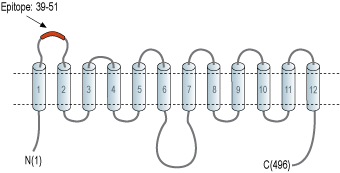Overview
- Peptide (C)KEFINKTLTDKGN, corresponding to amino acid residues 39-51 of human GLUT3 (Accession P11169). 1st extracellular loop.

This antibody will also recognize the human paralog GLUT14 /SLC2A14 (Accession Q8TDB8). Homology – 12/13 amino acid residues identical. The GLUT14 gene is specific to humans and has an overall 94.5% amino acid identity to GLUT3.
 Western blot analysis of human U-87 MG glioblastoma cell line lysate (lanes 1 and 6), human THP-1 monocytic leukemia cell line lysate (lanes 2 and 7), human SH-SY5Y neuroblastoma cell line lysate (lanes 3 and 8), human MEG-01 megakaryoblastic leukemia cell line lysate (lanes 4 and 9) and human Jurkat T-cell leukemia cell line lysate (lanes 5 and 10):1-5. Anti-Human GLUT3 (extracellular) Antibody (#AGT-043), (1:500).
Western blot analysis of human U-87 MG glioblastoma cell line lysate (lanes 1 and 6), human THP-1 monocytic leukemia cell line lysate (lanes 2 and 7), human SH-SY5Y neuroblastoma cell line lysate (lanes 3 and 8), human MEG-01 megakaryoblastic leukemia cell line lysate (lanes 4 and 9) and human Jurkat T-cell leukemia cell line lysate (lanes 5 and 10):1-5. Anti-Human GLUT3 (extracellular) Antibody (#AGT-043), (1:500).
6-10. Anti-Human GLUT3 (extracellular) Antibody, preincubated with Human GLUT3 (extracellular) Blocking Peptide (#BLP-GT043).
- Morea, V. et al. (2017) Amino Acids 49, 1147.
- Ancey, P.B. et al. (2018) FEBS J. 285, 2926.
- Yan, N. (2017) J. Mol. Biol. 429, 2710.
- Olson, A.L. and Pessin, J.E. (1996) Ann. Rev. Nutr. 16, 235.
Glucose transporter 3 (GLUT3), encoded by SLC2A3 gene is a glucose transporter, specifically expressed in neurons.
GLUT3 is a uniporter carrier, it binds one molecule of substrate at a time and transports it across the membrane. Transport occurs down the substrate concentration gradient, thereby allowing a constant supply of blood sugar for cell’s metabolism. The substrate binding site of GLUT3 is alternatively accessible from either side of the membrane by conformational changes of the protein. Thus, it enables both intake and export of glucose, according to glucose levels in and out of the cell1.
In the context of cancer, tumor cells often increase their glucose consumption and lactate production. An increasing number of studies are identifying GLUT3 and GLUT1 as major participants in the accelerated metabolism demonstrated by cancer cells. GLUT3 and GLUT1 are also overexpressed in several types of cancer tumors and hence, efforts toward the elucidation of the structure and function of glucose transporters as targets for diagnosis and new cancer therapeutics are invested2.
GLUT3 shares a conserved fold that is made of two domains, N- and C-terminal, and six trans-membrane spanning α-helices each. The N- and C-terminal domains are connected by a third domain, comprising five short intracellular α-helices. The overall protein structure has roughly the shape of the letter “V”, with a cavity opened towards the extracellular side of the membrane that allows glucose to reach and bind to the substrate binding site3,4.
Application key:
Species reactivity key:
Anti-Human GLUT3 (extracellular) Antibody (#AGT-043) is a highly specific antibody directed against an epitope of the human protein. The antibody can be used in western blot and live cell flow cytometry applications. The antibody has been designed to recognize GLUT3 from human samples only. This antibody will also recognize the human paralog GLUT14 /SLC2A14.

